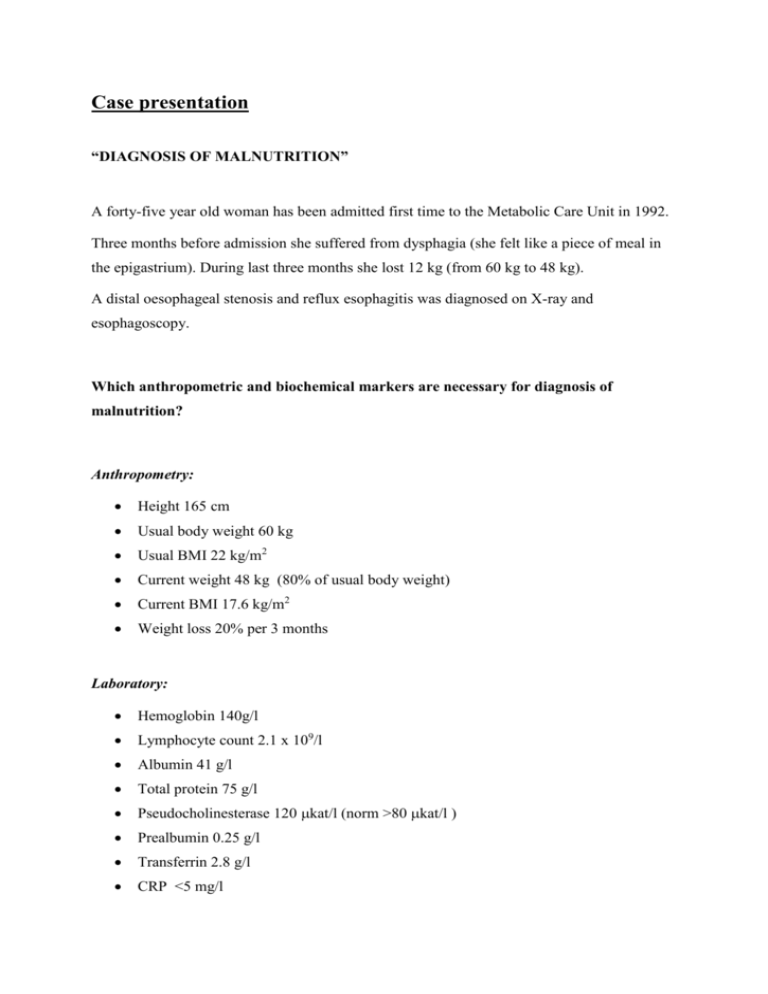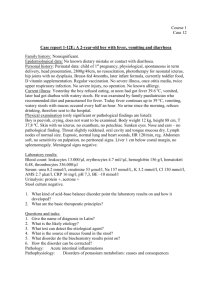Case presentation - The LLL programme in Clinical Nutrition and
advertisement

Case presentation “DIAGNOSIS OF MALNUTRITION” A forty-five year old woman has been admitted first time to the Metabolic Care Unit in 1992. Three months before admission she suffered from dysphagia (she felt like a piece of meal in the epigastrium). During last three months she lost 12 kg (from 60 kg to 48 kg). A distal oesophageal stenosis and reflux esophagitis was diagnosed on X-ray and esophagoscopy. Which anthropometric and biochemical markers are necessary for diagnosis of malnutrition? Anthropometry: Height 165 cm Usual body weight 60 kg Usual BMI 22 kg/m2 Current weight 48 kg (80% of usual body weight) Current BMI 17.6 kg/m2 Weight loss 20% per 3 months Laboratory: Hemoglobin 140g/l Lymphocyte count 2.1 x 109/l Albumin 41 g/l Total protein 75 g/l Pseudocholinesterase 120 kat/l (norm >80 kat/l ) Prealbumin 0.25 g/l Transferrin 2.8 g/l CRP <5 mg/l Na 142 mmol/l K 4.5 mmol/l Cl 105 mmol/l Ca 2.4 mmol/l P 1.2 mmol/l Which type of malnutrition can be diagnosed in this patient? She was treated by oesophageal dilatation therapy. During the first week of the treatment she was given liquid diet (oral supplements). The patient was supervised by dietician and she began to eat mixed liquid and then normal diet. Every three weeks she was admitted to the hospital for further oesophageal dilatation. Which nutritional markers should be examined during next period? During subsequent two months the nutritional status of patient improved. She has gained 5 kg of body weight (53 kg BMI 19.5 kg/m2). Then she was examined every 3 months in our outpatient department and her body weight and laboratory tests did not change. In 1993 the patient discontinued visiting hospital because she has felt healthy. She did not regain her body weight anymore. One year later (in 1994) she suffered from flu-like symptoms. Her fever was up to 39.5°C and the third day she began to take Aspirin. Her temperature dropped down slightly but she had heartburn-like pain. She was not able to eat and drink and so she had been transferred to a local hospital. A right side pneumonia has been diagnosed. Intravenous antibiotic therapy and parenteral rehydration (5% Glucose and 0.9% NaCl) was commenced. Because of lower limb oedema she was treated with Furosemide. However, this treatment had no effect on oedema formation. Patient has gained 10 kg of body weight during the subsequent week. Because of hypoalbuminemia and potassium and phosphorus depletion the patient has been referred to the Metabolic Care Unit. She was febrile, suffered from extreme fatigue and leg oedema (up to half of thigh). During examination the doctor observed right lower segment pneumonia. Partial stenosis of lower oesophagus (0.5) and ulcerations at oesophageo-gastric junction were diagnosed. Anthropometry: Height 165 cm Usual body weight 60 kg (53 kg last year) Usual BMI 22 kg/m2 Current weight 63 kg (105% of usual body weight) Current BMI 23.7 kg/m2 Weight gain 19% per 2 weeks Laboratory: Hemoglobin 99/l Lymphocyte count 0.8 x 109/l Albumin 19 g/l Total protein 45 g/l Pseudocholinesterase 24 kat/l Prealbumin 0.08 g/l Transferrin 1.2 g/l CPR 80 mg/l Na 132 mmol/l K 2.4 mmol/l Cl 99 mmol/l Ca 1.65 mmol/l P 0.25 mmol/l Which type of malnutrition can be diagnosed? Should diuretic therapy be useful in this particular patient? Should we start with oesophagus dilatation therapy in this stage? Should we start TPN? Questions for general discussion: - What types of malnutrition were seen in this patient during two stays in our clinic? - What was the etiology of malnutrition diagnosed during the first stay in our hospital (1992)? - What was the etiology of malnutrition diagnosed during the second admittance to our hospital (1994)? - Why the patient gained her body weight in 1994? - Was hypoalbuminemia caused by low protein intake? - Which type of malnutrition is more dangerous before operation? - Which type of malnutrition is connected with decreased or increased ketogenesis?






